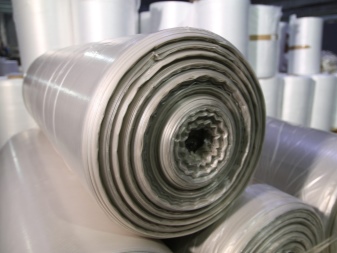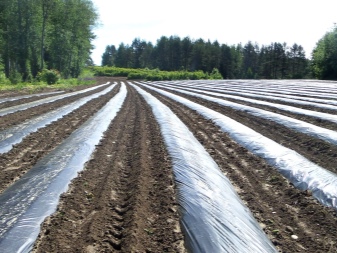Varieties and uses of technical films

The modern world cannot be imagined without plastic that has flooded all areas of our life. A huge part of this "plastic sea" is made up of various film materials, including technical films, which are in demand in many industries.


Features and properties
Polyethylene technical film is the result of the remelting of second-hand premium grade polyethylene or waste of its production. It is not used for packaging medicine and food. The most pronounced difference between the technical variety and the products of the first and highest grades is the appearance. The film does not look perfectly transparent, has inclusions of unmelted particles, their amount depends on the degree of purification. With recycled polyethylene, a non-uniform thickness is acceptable. But in terms of mechanical properties, this economical material is not inferior to primary polyethylene.
The finished product is not a toxic product, but the release of harmful vapors is possible in the process of recycling in production. No precautions are required for its use indoors or outdoors, except for a fence against open fire. Film is a highly flammable product. When ignited, polyethylene burns and melts, releasing dangerous aldehydes.
For films used in finishing, insulation works in premises, a fire certificate of conformity is required, which regulates the safety of the product.


The main characteristics of industrial films:
- specific sweetish odor (not indicative of toxicity);
- rough surface;
- low (in comparison with grade 1) level of light transmission;
- a shade from slightly gray or yellowish to colored and black (with the addition of dyes or soot);
- moisture resistance;
- tightness;
- a light weight;
- resistance to temperatures from -60 to + 60 °;
- good tensile strength and tensile strength in the longitudinal and transverse directions;
- damage resistance also grows depending on the thickness;
- low cost;
- wide range of;
- warranty period of operation - from 3 years or more.
Aging of polyethylene occurs from exposure to sunlight: the material becomes dull and brittle. Adding light stabilizers helps solve the problem.


Production
The main negative property of plastic polymers is the long term of their natural decomposition. By including in the composition of special biodegradable additives, this process can be accelerated, but still the planet is literally suffocating from such waste. More recently, plastic was disposed of in only 2, in fact, barbaric methods: incineration and burial.
Recycling the material to obtain a technical film is an excellent solution that is economically and environmentally friendly. Recyclable materials for recycling polyethylene:
- unused products recognized as manufacturing defects;
- industrial waste of the same type;
- sorted waste.


Rejects in production make up a very small part of the total mass of raw materials: about 10%. Therefore, during processing, the sorting and purification of polymers that have already been used are in the foreground. The process of recycling polyethylene in production looks like this:
- collected recyclables are sorted, washed and cleaned;
- the material is crushed in a crusher;
- remove excess impurities and moisture using a centrifuge;
- thoroughly dry;
- in a granulator or agglomerator, granules or agglomerate (polyethylene crumb) are formed from molten raw materials.


Agglomerator is a special device that can have either a simple design with manual loading of raw materials and water, or be a complex computerized complex. The molten polymer raw material in the agglomerator is cooled by the shock supply of cold water, while sintering forms a kind of flakes (agglomerate). The products obtained in the granulator and agglomerator are different. For example, the clarity of the secondary granules will be higher than that of the agglomerate.
And also granules have a more uniform structure and bulk density. The film produced from them will be little inferior to the primary material in quality and transparency. The final product is obtained by loading the crumb into an extruder and passing it through a screw at high temperatures. Then the film web passes through the forming heads of different profiles, cools, unwinds on rollers and prepares for distribution to retail chains in rolls.


Species overview
The classification of technical films depends on their composition. When recycled, the properties of the resulting material will depend on the raw material: it is impossible to convert LDPE (high pressure) polyethylene after recycling into HDPE (low pressure) and vice versa.
The maximum width of the polyethylene sheet is 6000 mm. The width for grades B and B1 is 3000 mm and more, for the SIK category - 1500 mm and more, for SM - more than 800 mm. The length of the film in a roll ranges from 50 to 200 m. An important characteristic is the thickness, it is measured in microns (microns). The most popular indicators: 80 microns, 100 microns, 150 microns, 200 microns. The film is produced according to technical specifications or the following standards:
- technical polyethylene film GOST 10354-82;
- shrink film GOST 25951-83;
- HDPE GOST16338-85;
- LDPE GOST 116337-77.


Forms of technical film production:
- the canvas is a continuous seamless material without folds;
- sleeve - polyethylene pipe, produced with folded folds - folds or without them;
- half-sleeve (this is a sleeve cut on one side along the fold), it can be expanded into a solid canvas.
Another classification divides the product into brands that are used for different purposes:
- M - the brand is used in the production of bags;
- T - common in construction;
- ST and SIK - are in demand for arranging greenhouses, greenhouses;
- SK - for the preservation of feed in animal husbandry, poultry farming;
- SM - for covering the ground in order to preserve moisture (mulching);
- В, В1 - in land reclamation and water management;
- H - for household use as a packaging material.

Areas of use
Technical film serves as a universal solution to many problems of the agricultural sector and is used:
- when mulching the soil;
- for sheltering greenhouses and haylages;
- when arranging silo and sewage pits, drainage trenches;
- for storage and transportation of agricultural products.
This product is in great demand in construction. Everyone has seen scaffolding covered with polyethylene. Under such protection, you can continue to work even in bad weather. The technical black film plays the role of an excellent insulating material in such manipulations:
- roofing and facade works;
- laying the foundation (for protection from groundwater);
- laying of pipes.


Polyethylene for waterproofing is advantageous in that it is thin, but dense, does not rot and is not subject to the action of bacteria. The building materials unloaded onto the site are sheltered from rain and sun with a polyethylene sheet. Not a single internal or external renovation of premises is complete without technical film, which is used to hang windows and walls, cover floors and furniture so that they do not get dust, plaster and paint. Wide range of applications - packaging of all kinds of non-food products, such as:
- window and door blocks;
- finishing materials (wallpaper, adhesives, mixtures);
- rolls of fabrics;
- paper, books and stationery;
- furniture;
- Appliances;
- household chemicals;
- various devices and tools.


The film plays the role of additional protection for cardboard containers, ensuring the tightness and safety of the contents. In any home you can find garbage bags made of technical polyethylene of various capacities.
Affordability, wide assortment, ease of use make this material attractive in many industries and in our everyday life.
In the next video you will find a quick overview of the technical film.













The comment was sent successfully.